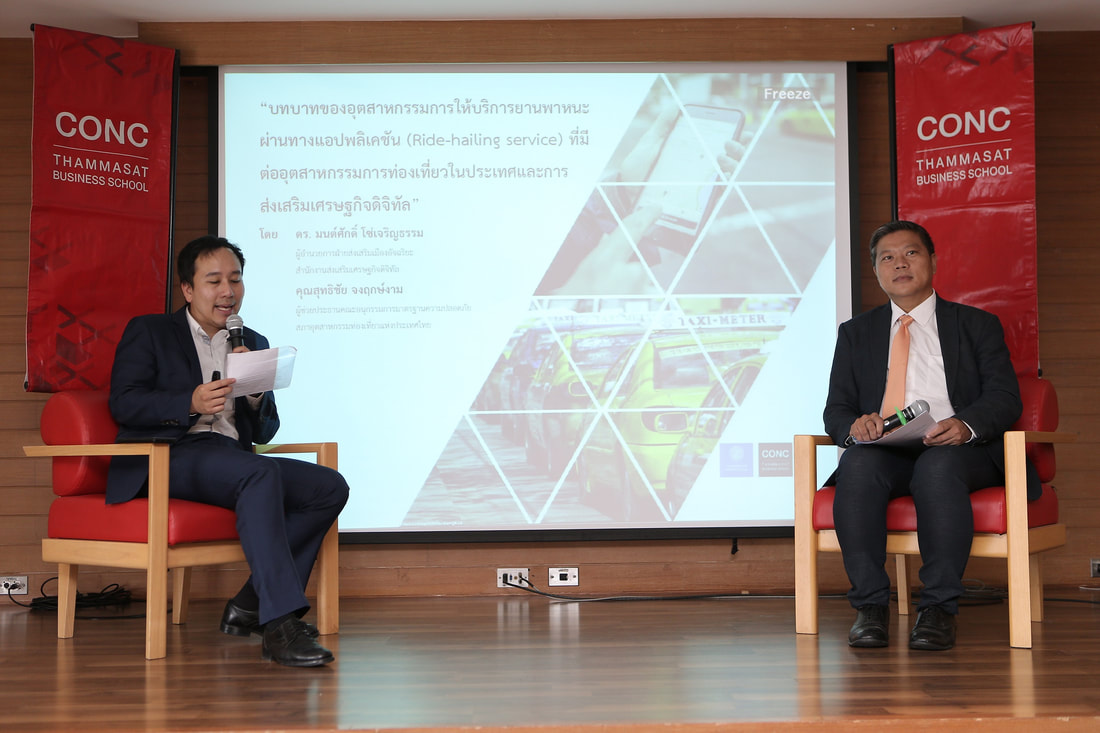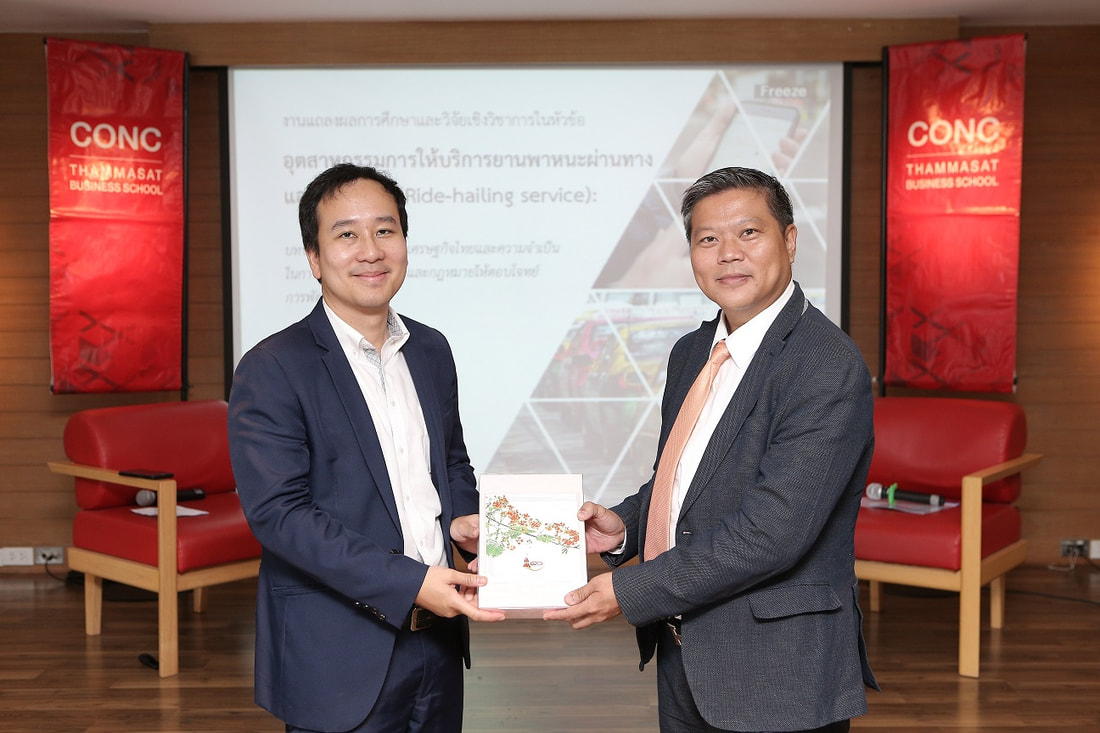CONC Thammasat: Ride-hailing contributed THB 21 billion to Thailand’s economy in 2018, expected to reach THB 120 billion by 2025
Thammasat Consulting Networking and Coaching Center (or CONC Thammasat) today announced the findings of its research which focused on “The role of ride-hailing in driving Thailand’s economy and the necessity of developing sustainable guidelines and regulations”. The research study highlighted the economic and social impact of ride-hailing to Thailand and provided 5 key actionable guidelines and best practices for the government to consider as they work towards the legalisation of ride-hailing in Thailand by March 2020.
Dr. Suthikorn Kingkaew, Director of Thammasat Consulting Networking and Coaching Center, Faculty of Commerce and Accountancy, Thammasat University said, “Ride-hailing has changed the way people move, not just in Thailand, but around the world. It has naturally risen in popularity in today’s digital age where mobile and Internet penetration is high, and people are increasingly receptive of leveraging technology to make their point-to-point travel as hassle free as possible. Thailand’s urban population is expected to grow from the current 50% to 73% within the next 30 years, which signals that people’s expectations for accessible, seamless and safe transportation will continue to increase. The time is now for the government to legalise ride-hailing so as to integrate it as part of the entire public transportation ecosystem to serve the needs of Thai commuters as well as visitors to the country.”
The Thai ride-hailing industry currently accounts for 6% of Thailand’s ground transport sector’s GDP or THB 21 billion in 2018. With the legalisation of ride-hailing in Thailand, it is estimated that the total value of the ride-hailing industry will reach up to THB120 billion baht by 2025, or 20-25% of the ground transport sector’s GDP. In 2018, the ride-hailing industry is estimated to serve 2.4 million passengers per month, and this is expected to increase to up to 11 million passengers per month by 2025. Correspondingly, the number of ride-hailing drivers is forecasted to increase from 105,000 per month in 2018, to up to 590,000 per month by 2025, which means more Thai people will be given access to new income-earning opportunities.
Dr. Suthikorn Kingkaew added, “Our research shows that Thai people yearned for ride-hailing to be legalised to bring about greater peace of mind and welcomed the government’s recent move to do so. According to public polls conducted, 95% of consumers surveyed supported the legalisation of ride-hailing, while more than 77% urged for the legalisation of ride-hailing to be implemented as soon as possible. Thailand is one of the last 3 countries in Southeast Asia which has yet to legalise ride-hailing. The government recognises the benefits that ride-hailing brings to Thai people’s daily lives and sees the complementary role that ride-hailing plays to the entire public transportation ecosystem. The next crucial step forward is to develop fair and sound regulations that best safeguard public interests, and yet allow innovation to thrive.”
Dr. Suthikorn Kingkaew, Director of Thammasat Consulting Networking and Coaching Center, Faculty of Commerce and Accountancy, Thammasat University said, “Ride-hailing has changed the way people move, not just in Thailand, but around the world. It has naturally risen in popularity in today’s digital age where mobile and Internet penetration is high, and people are increasingly receptive of leveraging technology to make their point-to-point travel as hassle free as possible. Thailand’s urban population is expected to grow from the current 50% to 73% within the next 30 years, which signals that people’s expectations for accessible, seamless and safe transportation will continue to increase. The time is now for the government to legalise ride-hailing so as to integrate it as part of the entire public transportation ecosystem to serve the needs of Thai commuters as well as visitors to the country.”
The Thai ride-hailing industry currently accounts for 6% of Thailand’s ground transport sector’s GDP or THB 21 billion in 2018. With the legalisation of ride-hailing in Thailand, it is estimated that the total value of the ride-hailing industry will reach up to THB120 billion baht by 2025, or 20-25% of the ground transport sector’s GDP. In 2018, the ride-hailing industry is estimated to serve 2.4 million passengers per month, and this is expected to increase to up to 11 million passengers per month by 2025. Correspondingly, the number of ride-hailing drivers is forecasted to increase from 105,000 per month in 2018, to up to 590,000 per month by 2025, which means more Thai people will be given access to new income-earning opportunities.
Dr. Suthikorn Kingkaew added, “Our research shows that Thai people yearned for ride-hailing to be legalised to bring about greater peace of mind and welcomed the government’s recent move to do so. According to public polls conducted, 95% of consumers surveyed supported the legalisation of ride-hailing, while more than 77% urged for the legalisation of ride-hailing to be implemented as soon as possible. Thailand is one of the last 3 countries in Southeast Asia which has yet to legalise ride-hailing. The government recognises the benefits that ride-hailing brings to Thai people’s daily lives and sees the complementary role that ride-hailing plays to the entire public transportation ecosystem. The next crucial step forward is to develop fair and sound regulations that best safeguard public interests, and yet allow innovation to thrive.”
Findings from the CONC Thammasat’s research quantified the economic and social impact of ride-hailing to Thailand, reflecting opinions from 2,000 passengers and drivers in a series of public polls conducted from August to September 2019.
- Passengers: Overall, passengers surveyed opined that ride-hailing has made their daily transportation more convenient and gave them greater peace of mind due to higher safety standards being put in place.
- 92% of passengers agreed that ride-hailing service is safer than other alternatives.
- 95% of passengers opined that ride-hailing service serves their first-mile-last-mile needs, connecting them easily to other modes of transportation.
- 77% of passengers found it easy book a ride through ride-hailing apps and it reduces their waiting time
- 86% of passengers said that ride-hailing service allows them to spend more time on work or other activities during their ride
- Drivers: Drivers surveyed generally found ride-hailing as a new income stream to earn a living and give them greater financial independence.
- 60% of private-hire car drivers surveyed were unemployed or retirees before they found their income-earning opportunities through ride-hailing
- 99% of taxi drivers surveyed said that ride-hailing service has brought them more passenger bookings and helped them earn more income on top of street-hails
- 94% of drivers surveyed said the income they earned through ride-hailing has given them greater financial independence and helped them pay off their existing debts.
- Social Sector: Besides bringing greater convenience that enables passengers to get from one point to another, ride-hailing has raised the bar for transportation safety in Thailand by allowing for live location tracking and sharing using mobile GPS data, emergency SOS assistance to the police through the app, and other advanced safety technologies such as facial recognition and telematics that aim to protect driver and passenger safety.
- Economy: Ride-hailing is estimated to have directly contributed THB 21 billion to Thailand’s economy in 2018. This does not yet include the positive knock-on effect on the wider economy as ride-hailing improves drivers’ livelihoods and their spending power as consumers.
- Tourism Sector: Ride-hailing is a powerful driver of the tourism economy in Thailand. Tourists increasingly rely on ride-hailing for their travel, as 75% of foreign visitors now travel in small groups or as individuals, while the proportion of large travel groups has decreased to 25%. Ride-hailing also helps reduce the language barrier between tourists and Thai drivers through a in-app chat translation feature and eliminate tourists’ frustration of having to haggle with fares by displaying the pricing upfront before they book a ride.
Recognising the positive impact of ride-hailing to Thailand’s economy and society, CONC Thammasat applauds the government for taking a right and bold step forward towards the legalization of ride-hailing in Thailand, which is in line with the nation’s 4.0 vision. CONC Thammasat has conducted a robust consultation process, taking into account recommendations from government, ride-hailing, taxi, passenger and driver representatives, in developing the following 5 key guidelines and best practices that aims to support the government in developing the ride-hailing regulatory framework:
2. Setting high service quality standards for drivers, with safety as top priority
3. Enabling high service quality standards for service providers to be ready to operate a transport business at a national scale
4. Fair and equitable pricing for passengers and drivers driven by market forces to balance demand and supply
5. Setting basic requirements for service providers today with the anticipation of them becoming a critical part of Thailand’s future transport infrastructure
“Ride-hailing is a crucial jigsaw to complete the public transportation ecosystem in Thailand. Looking from the lens of the larger benefits to the country, all players in the industry should stay open to this inevitable trend that has brought immense benefits to the economy and society. Ultimately, it’s the consumers that matter the most, and all players should aim to stay relevant and adapt to the changing needs of today’s mobile users. More importantly, ride-hailing brings huge troves of data which are previously non-existent with traditional transportation modes. The potential of analyzing this big data to solve traffic congestion issues, prevent safety incidents and develop smart mobility solutions yields immense rewards for the nation and our citizens in the long term,” concluded Dr. Suthikorn.
- Setting minimum transportation safety standards to protect driver and passenger safety. All industry players providing transportation service should have these safety standards in place:-
- Advanced safety technology features, including real-time location tracking and sharing using mobile GPS, in-app emergency button connected to the police, telematics to ensure driving safety
- Driver and passenger verification technology such as facial recognition
- Channel for easy reporting of safety issues during a ride or post-ride, and 24/7 customer support service
- Personal accident insurance for drivers and passengers for every trip
2. Setting high service quality standards for drivers, with safety as top priority
- Drivers need to pass stringent background checks, including criminal record checks, before allowing to take a ride
- Clear code of conduct needs to be put in place for drivers
- Drivers need to go through road safety training
- While allowing private-hire car drivers to earn an income through their own personal vehicles, necessary vehicle safety checks should be put in place to ensure driving safety
3. Enabling high service quality standards for service providers to be ready to operate a transport business at a national scale
- Ensure the stability and reliability of the app and back-end technology systems at all times to support the customer volume and any business expansion nationwide
- Ensure sufficient driver supply to meet the demand of passengers at a national level
- Service providers should have the ability to serve tourists such as in-app chat translation and have the application be supported in multiple languages
- Service providers should be able to provide a variety of payment options, including cash, debit and credit cards
4. Fair and equitable pricing for passengers and drivers driven by market forces to balance demand and supply
- The fare pricing should be calculated based on dynamic pricing model which represents real-time demand and supply at the point in time, taking into account externalities such as weather and traffic conditions.
- The fare pricing should be displayed upfront to the passengers for them to make an informed choice before accepting the ride.
- The fare pricing should balance the needs of drivers and passengers based on the free-market dynamics of demand and supply. This will enable the driver to earn sustainable incomes, at a fare pricing that is acceptable and reasonable for passengers.
5. Setting basic requirements for service providers today with the anticipation of them becoming a critical part of Thailand’s future transport infrastructure
- Must be a legally registered company in Thailand
- Majority of the shareholders in the company should be Thais or Thai company
- Must make local tax contributions
- Must have enough capital to support business operations such as ensuring drivers earn sustainable incomes and the expansion of the business into every city in Thailand
“Ride-hailing is a crucial jigsaw to complete the public transportation ecosystem in Thailand. Looking from the lens of the larger benefits to the country, all players in the industry should stay open to this inevitable trend that has brought immense benefits to the economy and society. Ultimately, it’s the consumers that matter the most, and all players should aim to stay relevant and adapt to the changing needs of today’s mobile users. More importantly, ride-hailing brings huge troves of data which are previously non-existent with traditional transportation modes. The potential of analyzing this big data to solve traffic congestion issues, prevent safety incidents and develop smart mobility solutions yields immense rewards for the nation and our citizens in the long term,” concluded Dr. Suthikorn.





















